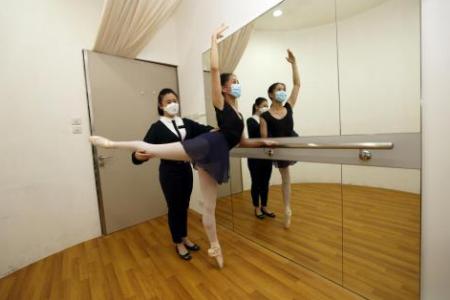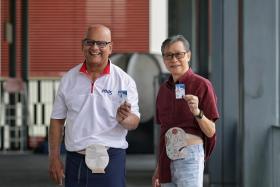Changi General Hospital rolls out programme to treat performing artistes
Miss Lam Kar Yi, 18, has been dancing and performing ballet since she was in Primary 2.
In February 2020, the dance graduate from School of the Arts Singapore (Sota) was diagnosed with patellar tendinitis - during a period when her training intensified in preparation for performances. Also known as jumper's knee, the condition is an overuse injury which occurs in people who do a lot of jumping due to significant increases in training load and/or intensity.
Miss Lam, who is trained in classical ballet and contemporary dance, underwent treatment at the Singapore Sport and Exercise Medicine Centre (SSMC) in Changi General Hospital (CGH), and also took a three-month break from dancing.
But it was not the first time she had sustained dance-related injuries. She first sought treatment, which included physiotherapy sessions, at CGH in March 2019. A few months later, she endured a dance assessment in school with puffy and swollen knees.
CGH's new Performing Arts Medicine initiative, rolled out on Dec 15, aims to help artistes like Miss Lam. Like athletes, the hospital notes, performing artistes also spend long hours training and can sustain injuries.
Under the initiative, a Performing Arts Medicine Clinic was launched at the SSMC at Novena Medical Center. It collaborates with the team at CGH to coordinate care and provide access to the hospital's full range of specialities.
The programme is helmed by two physicians from CGH's department of sport and exercise medicine who have an interest in dance medicine and instrumental medicine, as well as an ear, nose and throat surgeon with an interest in vocal medicine.
Along with a multidisciplinary team, they evaluate and treat medical conditions afflicting dancers, instrumentalists and vocalists at all performance levels.
Citing an international cross-sectional study published in 2017, CGH points out that as many as 84 per cent of dancers sustain dance-related musculoskeletal injuries, typically due to overuse.
The hospital also referred to a set of baseline findings from the Risk of Music Students, a research project set up in 2018 to identify factors associated with increased risk of playing-related musculoskeletal disorders in music students from pan-European institutions. The longitudinal multicentre study, published in 2020, found that the lifetime prevalence of playing-related musculoskeletal disorder in music students in Europe is between 62 and 93 per cent.
As for vocalists, they may be prone to laryngitis, vocal cord haemorrhages and polyps. They may also experience hoarseness and have poor vocal endurance that can interfere with the quality and clarity of their voice.
A performer can also be affected by a variety of ear, nose and throat disorders, which can include hearing loss, tinnitus, sinus disease and swallowing problems.
CGH is unable to say if the number of patients with performing arts-related injuries has increased in the last five years as the initiative was rolled out only recently.
However, it notes that the local arts and cultural scene has seen an uptick of performers and performances over the years. According to the Singapore Cultural Statistics in 2020, an average of 8,700 performing arts events were held each year from 2015 to 2019.

Dr Mandy Zhang, a consultant at the department of sport and exercise medicine, says: "The Performing Arts Medicine initiative provides a one-stop service designed for performing artistes, ranging from pre-participating screening and pointe-preparedness to injury diagnosis and management.
"We also work closely with other disciplines such as physiotherapy, psychology, diet and nutrition, orthopaedics and podiatry to help the artistes optimise their performance potential."
She leads the team of consultants who specialise in treating dance patients and was the doctor who treated Miss Lam.
After her diagnosis in February 2020, the teenager underwent focal shockwave therapy and attended monthly physiotherapy sessions. Attention was also given to strength and conditioning.
To ease Miss Lam back into dancing after a three-month break, Dr Zhang advised her not to dive straight into her old routines. For instance, she was told to avoid jumps.
After showing the doctor a recorded rehearsal of a Sota showcase, she was given the green light to participate in it.

Miss Lam, who graduated from Sota in October last year, was thankful that both Dr Zhang and her physiotherapist have a background in dance. "They understood what I meant when I described certain dance moves, which enabled them to give me better advice," she says.
Miss Lam, who goes back for follow-ups every six months and is hoping to join a local dance company as a part-time dancer, has learnt a vital lesson from her injuries.
"It's very important to check in with yourself. If you know something is wrong, you should get it checked as soon as possible," she says.
The performing arts industry welcomes CGH's initiative.
Associate Professor Chan Tze Law, vice-dean at the Yong Siew Toh Conservatory of Music, says: "While nothing can replace awareness and self-preservation, this new multidisciplinary initiative makes available professional healthcare and advice to musicians."
Get The New Paper on your phone with the free TNP app. Download from the Apple App Store or Google Play Store now


